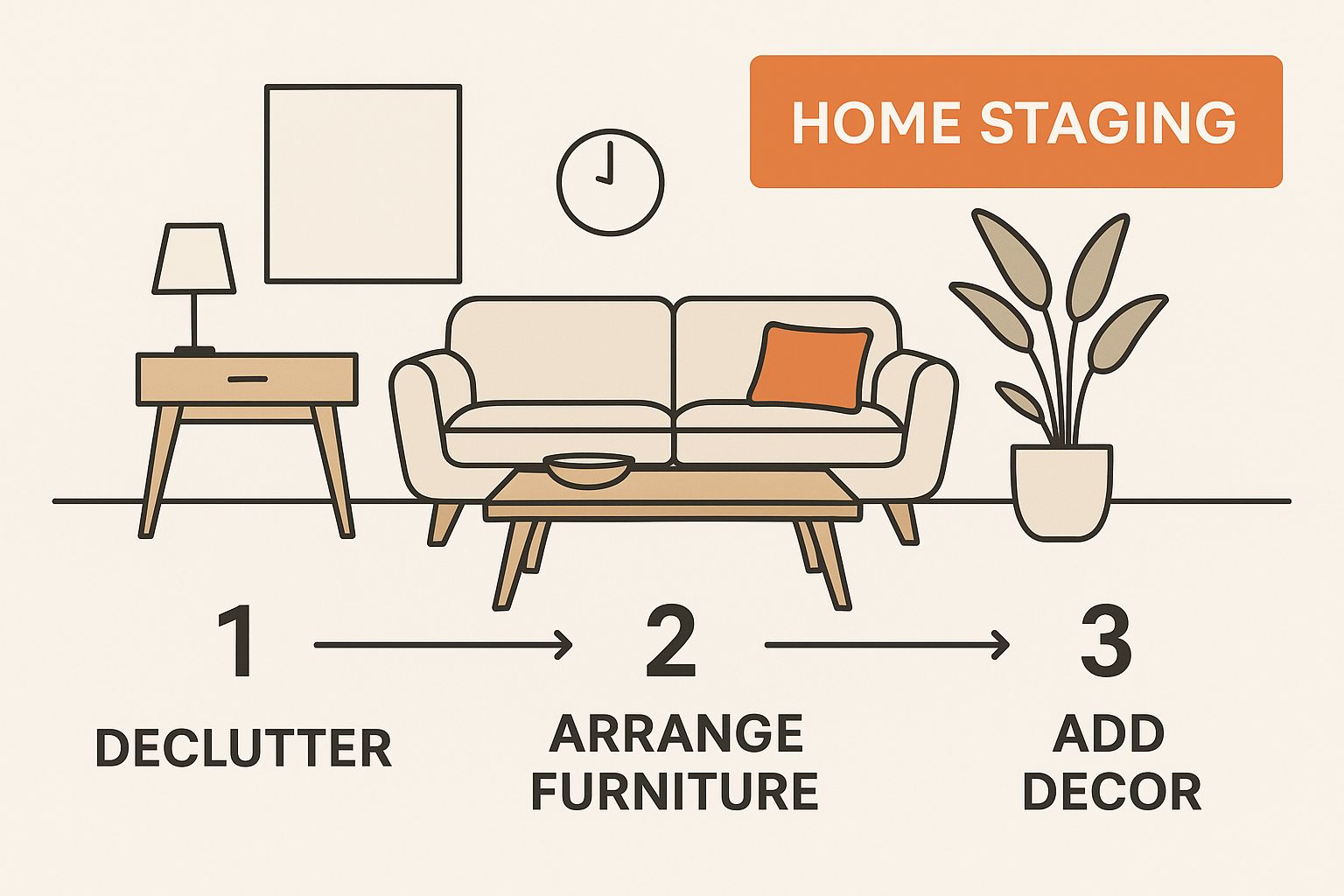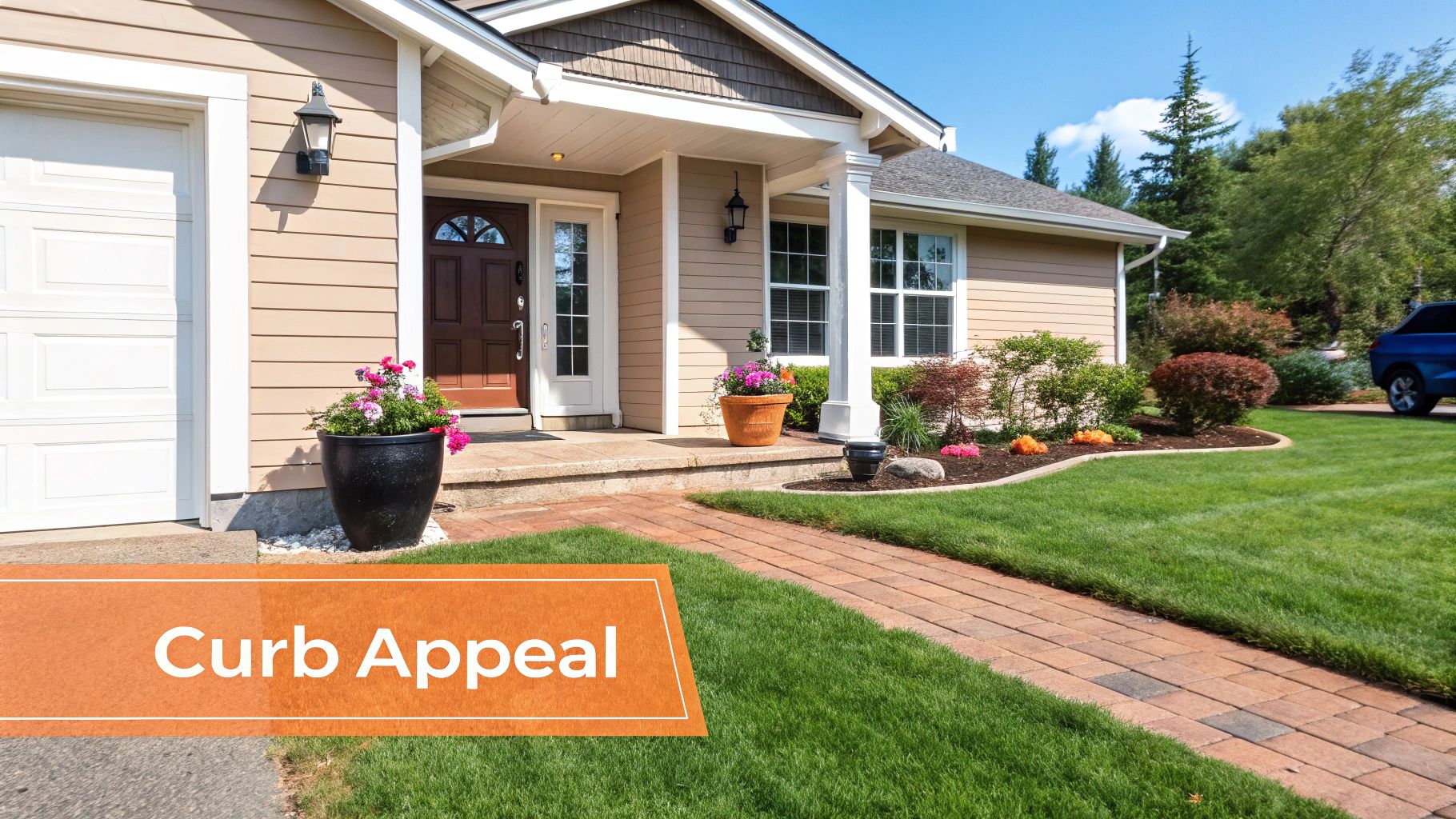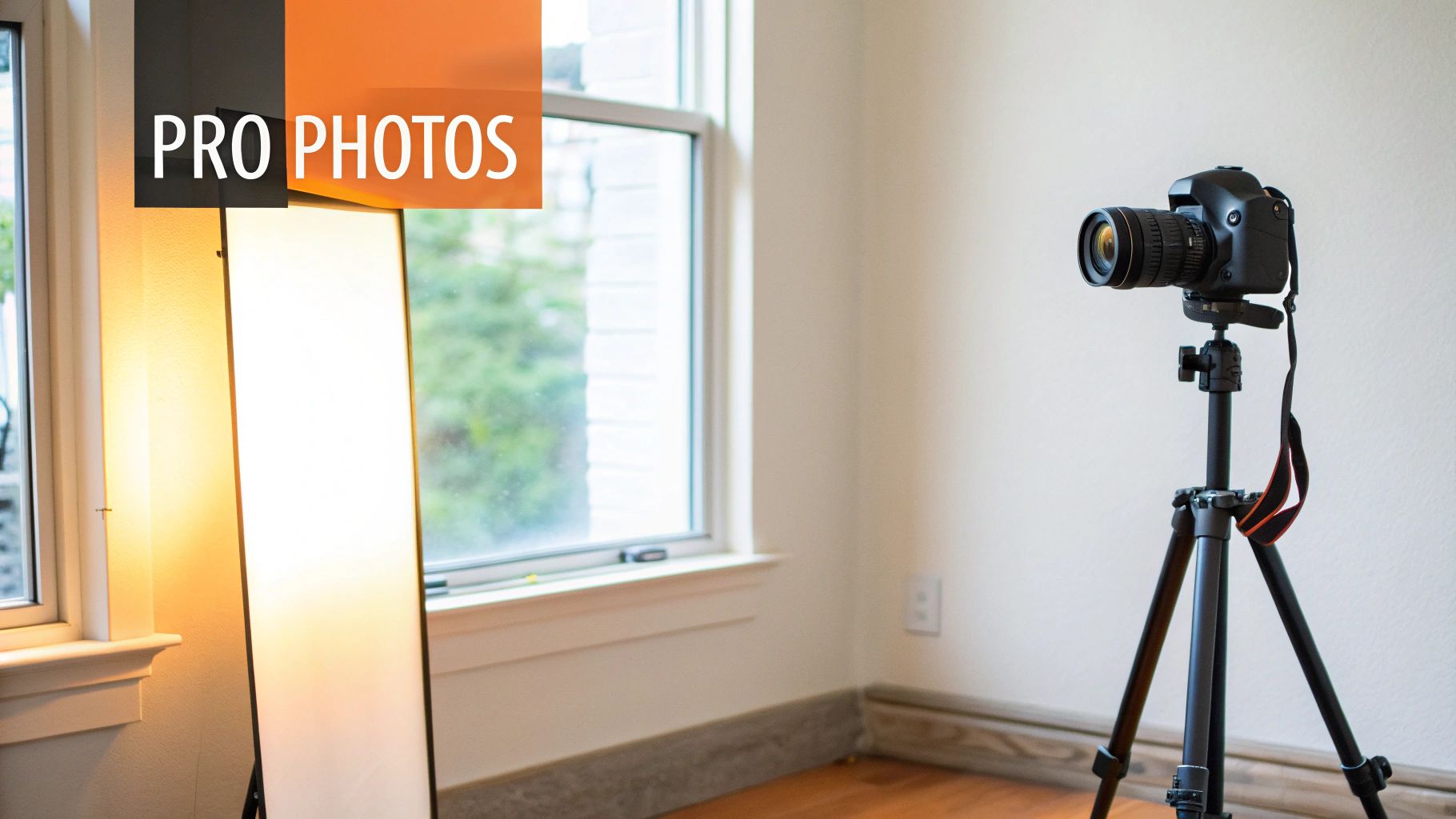How to Present a House for Sale: Tips to Attract Buyers
Learn how to present a house for sale effectively. Discover expert tips to showcase your home and attract more potential buyers quickly.
The secret to getting top dollar for your house isn't just about the location or the square footage. It's about making someone fall in love with it. You're selling more than a building; you're selling a future. That's why mastering how to present a house for sale is so crucial. It all boils down to creating an emotional connection that helps buyers see themselves living there, and that starts with strategic decluttering, deep cleaning, and thoughtful staging.
A home that's presented well just feels more valuable. It looks move-in ready and paints a picture of a life they could have.
Why First Impressions Win Bids
The very first time a potential buyer sees your home, whether it’s a tiny thumbnail online or the view from the curb, their mind is already making snap judgments. That first impression is incredibly powerful and colors their entire perception of the property.
You’re not just showing off four walls and a roof. You're trying to sell a feeling, a sense of comfort, and the idea of "home." When you get the presentation right, you're not just conducting a transaction—you're creating an emotional pull that can lead to quicker offers and a better final price. It's a smart blend of psychology and practical strategy.
The Power of a Blank Canvas
Think about it from a buyer's perspective. They’re not just looking for a structure; they're searching for a place where they can imagine their own life unfolding. A space crammed with personal belongings and clutter can feel like you're walking through someone else's life, which makes it nearly impossible for them to picture their own.
Imagine you're touring two houses. The first is packed with family photos on every wall, has bright, taste-specific paint colors, and furniture that makes the rooms feel cramped. It’s clearly a home, but it feels like someone else's home.
Now, step into the second house. The walls are painted in a soft, neutral tone. The furniture is arranged perfectly to show off the size of the room and create an easy flow. Instead of personal photos, there’s simple, tasteful art. This home feels like a fresh, welcoming canvas.
A buyer’s decision is often made within the first few minutes of a viewing. Your job is to make sure those minutes are filled with positive feelings of space, light, and possibility, not distraction.
That second scenario is exactly what you're aiming for. By depersonalizing and clearing out the clutter, you're essentially handing the imaginative keys over to the buyer. You’re giving them the mental space to "move in" their own furniture and start dreaming.
To really nail this, it's helpful to think of the core tasks and what they achieve.
Core Presentation Pillars and Their Impact
This table breaks down the essential tasks for presenting your home and clarifies the specific benefit each one brings to the table.
| Presentation Task | Primary Goal | Impact on Buyers |
|---|---|---|
| Decluttering | Create a sense of space and openness. | Makes rooms feel larger and allows buyers to envision their own items in the space. |
| Deep Cleaning | Signal that the home is well-maintained. | Builds trust and suggests the home has been cared for, reducing perceived repair costs. |
| Depersonalizing | Remove personal taste and memories. | Creates a neutral "blank canvas" so buyers can emotionally connect with the property. |
| Staging | Define each room's purpose and flow. | Helps buyers understand the home's layout and highlights its best features. |
Focusing on these four pillars ensures you’re not just tidying up; you're strategically marketing your property to the widest possible audience.
From Presentation to Profit
The time and energy you invest in presentation pays off—literally. A well-prepared home signals to buyers that the property is a high-value asset that's been looked after. It's no surprise that these homes often attract more competitive bids, simply because they stand out from the crowd.
The numbers back this up. Real estate studies consistently show that professionally staged homes can sell 17% faster and for about 6% more than homes that haven't been staged. This isn't just about making things look pretty; it's a smart marketing investment. Great presentation helps buyers see the property’s full potential, making them far more eager to make it their own. For a deeper dive, you can find more details on how property presentation impacts market value in this global real estate report.
Decluttering and Cleaning Like a Pro
Before you even think about staging, you’ve got to create a clean, blank slate. This isn't your average weekend tidy-up. I'm talking about the foundational work that makes everything else—the beautiful photos, the successful open house—even possible. Think of it this way: you can't paint a masterpiece on a dirty canvas.
A cluttered home just feels small and chaotic. It's tough for buyers to see the home's potential when they're distracted by your stuff. Your mission is to get rid of those distractions and open up the space. A great first step is learning how to effectively declutter your home to really set an inviting tone.
This is about more than just clearing space; it’s about depersonalizing. Buyers need to be able to picture their lives in your house. That's incredibly hard to do when they're staring at your family photos, personal collections, and quirky decor. Removing these things creates a neutral backdrop where their own dreams can take root.
The Art of Strategic Subtraction
Here's a trick I've seen professional stagers use time and time again: the "one-third rule." It's simple but powerful. When you're tackling closets and storage spaces, don't just organize them—remove at least one-third of everything inside. It instantly makes closets, pantries, and cabinets feel way bigger, signaling to buyers that there's plenty of storage.
Apply that same thinking to your surfaces. Kitchen counters, bathroom vanities, bookshelves... they should be almost completely clear. You can leave a couple of carefully chosen, impersonal decorative pieces, but that's it. This is what shifts a room's vibe from "lived-in" to "move-in ready."
Just look at the difference it makes. A cluttered room feels cramped, while a thoughtfully staged one feels open and full of possibility.

As you can see, simply minimizing the furniture and decor creates a much more welcoming living area that will appeal to a wider audience.
Deep Cleaning the Overlooked Details
With the clutter gone, it’s time to deep clean. I mean really deep clean. Buyers notice the little things, and a sharp-eyed buyer will interpret a dirty corner as a sign of lax maintenance overall.
Focus on the spots that pack the biggest punch:
- Baseboards and Trim: Get down there and wipe them all down. Clean trim makes an entire room look crisp and well-kept.
- Light Fixtures and Switches: Dust and polish every light fixture, ceiling fan, and switch plate. These high-touch areas collect more grime than you'd think.
- Windows and Blinds: Clean your windows inside and out until they sparkle. Nothing makes a home feel gloomier than dirty glass.
- Grout and Caulking: Scrub the tile grout in your kitchen and bathrooms. If it's badly stained, a grout pen or a professional cleaning can make it look brand new.
A truly pristine home sends a powerful message: this property has been meticulously cared for. It builds subconscious trust and eases buyers' fears about hidden problems and future repair costs.
Honestly, one of the smartest investments you can make is hiring professional cleaners for a one-time deep clean. For a few hundred dollars, you get a spotless home without the back-breaking work. That small expense almost always pays for itself with a faster, more confident offer.
Staging Your Home to Inspire Buyers

Alright, your home is clean and decluttered. Now for the fun part: staging. This is where you shift from just showing a property to selling a dream. Staging isn't about covering up problems; it’s about making your home’s best assets shine and helping buyers picture themselves living there.
The real magic happens when you create an atmosphere that speaks to a wide range of people. You’ll want to define each room's purpose, arrange furniture to make the space feel open and inviting, and use neutral colors to create a calm, cohesive backdrop. Think of your home as a canvas where potential buyers can paint their own future.
Defining Space and Creating Flow
Every room in your house needs a clear job. That extra room that’s become a catch-all for old hobbies and storage boxes? Let's turn it into a dedicated home office or a welcoming guest room. Even that odd little space under the staircase can become a charming reading nook with a comfy chair and a lamp.
How you arrange your furniture makes a huge difference. Try pulling your sofa and chairs away from the walls in the living room to create cozy conversation zones. It’s a simple move, but it instantly makes the room feel bigger and more intentional. The goal is to create a clear, easy path for buyers to walk through your home, guiding them naturally from one room to the next.
A well-staged home lets buyers move past the practical details and start imagining their new life. It answers the question, "How would we live here?" before they even think to ask it.
Adding Warmth with Light and Texture
Once the furniture is set, it's time for the finishing touches that bring a space to life. These are the details that keep a neutral home from feeling cold or sterile.
A few small changes can have a massive impact:
- Let there be light. Open every blind and curtain to flood the rooms with natural light. On top of that, make sure each room has a good mix of lighting—overhead fixtures, reading lamps, and maybe a small accent light—to create a bright, cheerful mood at any time of day.
- Bring in soft textures. Think fluffy towels in the bathroom, a soft throw draped over the arm of a sofa, and some stylish cushions on the beds and chairs. These little additions add color, depth, and a feeling of comfort.
- Decorate with a light touch. A simple vase of fresh flowers, a bowl of crisp green apples on the kitchen counter, or a couple of well-chosen books on the coffee table can make a room feel lived-in and polished without being overly personal.
If you’re ready to dive deeper and really make your property stand out, we have a complete guide full of https://pedra.so/blog/home-staging-tips. For even more great ideas, check out these essential staging your home tips. Taking these extra steps is what helps you connect with buyers on an emotional level and get the best possible offer.
Your Digital First Impression: Making Your Listing Unforgettable

Let's be honest—your home's first real showing isn't when a buyer walks through the front door. It happens on a laptop, a tablet, or a phone. Your online listing is your single most critical piece of marketing, and it has to be compelling enough to make someone stop scrolling.
This is where all that effort you put into cleaning and staging truly shines. Professional real estate photography is not a luxury; it's a must-have. Grainy, poorly lit photos taken on a phone can make even a stunning home look drab, costing you showings and, ultimately, serious offers.
Think of your home as a movie set on photoshoot day. A great photographer knows how to work with light and find the perfect angles, but they can't magically erase clutter. Your job is to give them a perfect canvas to work with.
Getting Ready for Camera Day
Before the photographer even rings the doorbell, you'll want to do a final sweep to make sure every room is ready for its close-up. Here’s a quick checklist I run through with my clients:
- Light it up. Turn on every single light in the house. That means lamps, overhead lights, and even the ones under your kitchen cabinets. A bright home always feels more welcoming.
- Let the sun in. Open all the blinds and pull back the curtains. Natural light is your best friend on photo day.
- Clear the decks. Remove everything from your kitchen and bathroom countertops. You can leave one or two simple, stylish decor items, but that's it.
- Hide the everyday stuff. Tuck away remote controls, tissue boxes, trash cans, and personal photos. The goal is to let buyers picture their life in the home, not yours.
Following these steps helps create those clean, spacious, and aspirational images that grab a buyer's attention.
A buyer’s first impression is almost always from your online photos. Investing in professional photography and prepping your home for the shoot isn't just a cost—it's one of the smartest marketing investments you can make.
Go Beyond Photos with Modern Tech
Great photos are the price of entry, but today's tools can give your listing a serious edge. Virtual tours and video walkthroughs aren't just novelties anymore; they drive real engagement. In fact, some studies show that listings with 3D virtual tours can sell up to 10% faster and increase buyer inquiries by around 30%. You can dig deeper into how these digital tools impact global real estate markets to see the effect on sales.
Here are a few game-changing assets to consider adding to your listing:
- 3D Virtual Tours: Platforms like Pedra can stitch your property photos into a fully immersive 3D tour. This allows buyers to "walk through" your home from anywhere in the world, which is a fantastic way to pre-qualify them. If they book a showing after seeing a 3D tour, you know they're already very interested.
- Drone Photography: If your property has a great yard, unique landscaping, or is in a killer location, drone shots are a no-brainer. They show off the scale and context of your home in a way that ground-level photos simply cannot capture.
- Video Walkthroughs: A short, well-edited video does more than just show rooms; it tells a story. It can create an emotional connection and bring the home to life in a way static images can't.
These tools don't just display your property—they create an experience. And that experience is what helps turn a casual browser into a serious buyer ready to make an offer.
Adding the Final Touches for Unforgettable Showings
You’ve done the heavy lifting. The clutter is gone, the staging looks incredible, and the professional photos are stunning. Now it's time for the final, crucial step: prepping for the actual in-person showings. This is where your property goes from looking great online to feeling like "the one" in person. The small, thoughtful details you add now can create a powerful emotional connection the moment a buyer walks through the door.
Think about the feeling you get when you walk into a luxury hotel. It's bright, smells amazing, and feels instantly welcoming. You can create that very same vibe in your own home with just a little effort before each viewing.
First Impressions and Curb Appeal
A buyer’s first impression is formed the second they pull up to the curb. You have to make it count. A freshly painted front door in a classic, inviting color like deep navy, bold red, or timeless black can completely transform your home's entrance.
Beyond the door, make sure the walkway is spotless. Sweep it clean, hide the garbage cans, and put down a brand-new welcome mat. If you have a porch, a few well-placed potted plants add a pop of life and color. And here’s a pro tip: turn on your exterior lights, even for daytime showings. It sends a clear signal of a warm, inviting home from the very first glance.
The goal is to make buyers feel genuinely excited before they even step inside. A pristine exterior subconsciously tells them the inside has been cared for with the same level of detail, building trust right away.
These simple things work together to create an overwhelmingly positive first impression that will stick with buyers long after they leave.
Engaging All the Senses
Once they’re inside, you want to keep building on that positive momentum. A house becomes a home when it appeals to more than just sight.
- Scent: Your home needs to smell one way: clean. Ditch the strong air fresheners, as they can set off allergies or make people wonder what you’re trying to cover up. The best approach is to open the windows for an hour before a showing to let fresh air circulate. If you want a subtle, welcoming aroma, try baking a small batch of cookies or simmering a few cinnamon sticks on the stove.
- Sound: A silent house can feel strangely sterile. Play some soft, ambient music at a very low volume. A simple instrumental playlist is perfect for setting a relaxed, sophisticated mood that encourages buyers to take their time.
- Temperature: Make sure your home is comfortable. Set the thermostat to a pleasant temperature so buyers can focus on the house itself, not on feeling too hot or too cold.
For a complete rundown of every little detail, our ultimate checklist for preparing your home for sale has you covered. These sensory touches might seem small, but they weave together to create a powerful, positive experience that helps buyers see themselves living there.
Answering Your Top Home Presentation Questions
Even after you've decluttered and cleaned, a few tricky questions always seem to surface right when you're about to list. I've heard them all over the years. Let's walk through some of the most common ones so you can handle them like a pro.
Getting these final details right is where the magic happens. It’s easy to get tripped up here, and even small oversights can lead to some of the most common mistakes people make when selling a house. Thinking through these scenarios now will put you in a much stronger position.
How Much Should I Spend on Staging My Home?
This is the million-dollar question, isn't it? While there’s no single price tag, the best advice I can give is to be strategic. Focus your budget on the “money rooms”—the ones that have the biggest emotional impact on buyers. That means prioritizing the living room, main bedroom, and kitchen.
You can actually accomplish a lot with a minimal budget. Start with the free stuff: a ruthless decluttering, a deep clean, and a thoughtful rearrangement of your furniture to make the space feel open and intuitive. If you have a few hundred dollars to spare, a one-time consultation with a professional stager can give you a high-value, customized plan.
Full staging is a bigger investment, of course, but it’s one that often pays for itself. A well-staged home can seriously boost the final sale price.
The goal isn't just to spend money; it's to make a strategic investment. Even small, targeted improvements can dramatically change a buyer's perception of your home's value and appeal.
Should I Hide the Fact That I Have Pets?
You don't need to pretend your furry family members don't exist, but you absolutely must erase every single trace of them before photos or showings. This is non-negotiable if you want to appeal to the widest pool of buyers.
First things first: deep clean. Have your carpets, rugs, and any upholstered furniture professionally cleaned to remove any lingering scents that you’ve probably gone nose-blind to. Scour the home for any pet-related damage, like scratched door frames or chewed baseboards, and repair them.
Right before any potential buyers walk through the door, do a final sweep and remove all pet paraphernalia. This includes:
- Food and water bowls
- Pet beds, crates, and blankets
- Toys and scratching posts
- Litter boxes (this is a big one!)
Your goal is to create a neutral space. You want a buyer with allergies or someone who simply isn't a pet person to see the house, not the evidence of who lives there.
Is It Better to Sell an Empty House or a Staged One?
I’ll make this one simple: a staged home almost always sells faster and for more money. It’s a strange phenomenon, but empty rooms are incredibly hard for buyers to connect with. Without furniture, they can feel sterile, smaller than they actually are, and lack a sense of purpose.
Staging does the heavy lifting for a buyer's imagination. It defines the purpose of each room and provides a crucial sense of scale. It helps them mentally place their own sofa or bed and start picturing their life there. Even just lightly staging the key areas—living room, dining area, main bedroom—makes an enormous difference.
An empty house is just a structure. A staged house feels like a home.
Ready to create stunning visuals that make buyers fall in love? With Pedra, you can instantly stage rooms, enhance photos, and generate virtual tours with a single click. See how easy it is to present your property in its best light and attract serious offers faster. Explore Pedra today.

Related Posts
3D Photography for Real Estate Guide
Explore our guide to 3D photography for real estate. Learn how immersive virtual tours can attract q...
Effective Copywriting for Real Estate to Sell Homes Fast
Discover expert copywriting for real estate that boosts property sales. Learn tips to craft compelli...
Top Floor Plan Creator Software of 2025 | Design with Ease
Explore the best floor plan creator software of 2025. Find intuitive tools and powerful features to ...